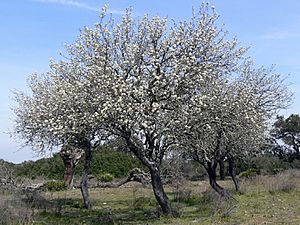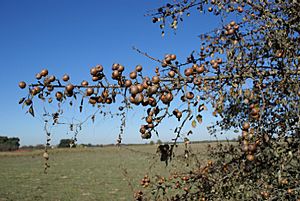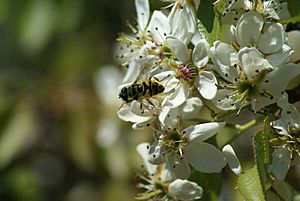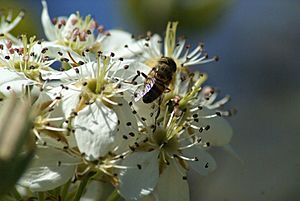Iberian pears facts for kids
Quick facts for kids Iberian pears |
|
|---|---|
 |
|
| Flowering Iberian pear group in the Doñana National Park (SW Spain) | |
| Scientific classification | |
| Genus: |
Pyrus
|
| Species: |
bourgaeana
|
| Synonyms | |
|
List
|
|
The Iberian pear (scientific name: Pyrus bourgaeana) is a wild tree. It is a close relative of the common pear, Pyrus communis, which people started growing about 2500 years ago. This small tree usually grows to be 3 to 6 meters tall. It is found in the southern Iberian Peninsula (Spain and Portugal) and northern Morocco.
The Iberian pear has white flowers, sometimes with a hint of pink. Each flower is about 2 to 3 centimeters wide and has five petals. Its fruits are round, like small apples, and weigh about 9.5 grams. They have green or brown skin, which makes them hard for birds to see. The fruits have many small spots called lenticels that let out a smell. Inside, the fruit is very fibrous and usually has 2 to 4 seeds.
In the Iberian Peninsula, these trees are spread out in small groups. They grow in Mediterranean scrublands. These areas are often separated by towns or farms. Iberian pears are very strong and can resist many sicknesses. Storms or strong winds are more likely to harm them than diseases.
Contents
Life Cycle and Animal Friends
The Iberian pear trees bloom with flowers in February and March. Many different insects help pollinate them. These include bees, flies, and beetles.
Each tree can produce between 200 and 450 fruits. These fruits ripen and fall to the ground from September to December. Most seeds are not eaten by small insects before they fall. Mammals often help spread the seeds.
How Animals Help Spread Seeds
Many meat-eating mammals, like badgers (Meles meles) and red foxes (Vulpes vulpes), eat the whole fruits that have fallen. When they digest the fruit, the seeds pass through their bodies. These seeds are then dropped in new places, ready to grow. This helps the pear trees spread. However, in some areas, hunting has reduced the number of these animals.
Other animals also eat the fruit. Rabbits (Oryctolagus cunniculus) and some birds eat the fruit's soft part. They often leave the seeds behind under the parent tree. Small animals like rodents might then eat these uncovered seeds.
Large hoofed animals, called Ungulates, such as red deer (Cervus elaphus) and wild boar (Sus scrofa), also eat the fallen fruits. But they usually grind up the seeds, so these seeds cannot grow. Rodents can also eat seeds after they have been spread.
Growing New Trees
Iberian pear seeds usually sprout soon after they fall. They can even start growing while still inside the fallen fruit. The seeds do not stay in the soil for a long time. New seedlings appear from winter to early spring. Many young seedlings die because of dry summers or fungal infections.
The Iberian pear trees often grow in small groups. This might happen for a few reasons:
- Animals like foxes and badgers help spread seeds, which can lead to new trees growing close together.
- Sometimes, seeds fall right under the parent tree and grow there. This happens if mammals don't eat all the fallen fruit.
- The trees can also grow new shoots from their roots, especially after being disturbed. These new shoots can grow into full trees, creating a cluster. In the Doñana National Park in Spain, red deer often eat the shoots. But new ones keep growing, which can also lead to groups of trees.
Uses and Threats
Pear wood from any pear species is known for its very fine texture. It is valued for making woodwind musical instruments. Thin sheets of pear wood, called veneer, are used to make beautiful furniture.
In southern Spain, the Iberian pear has been used as a rootstock. This means that other types of pear trees are grafted onto its roots. This helps the cultivated pear trees grow strong. The fruit of the Iberian pear itself is not eaten by people.
The biggest dangers to the Iberian pear are cities growing larger and more land being used for farming.
See also
 In Spanish: Pyrus bourgaeana para niños
In Spanish: Pyrus bourgaeana para niños





